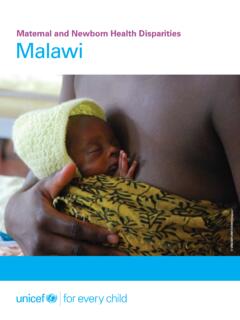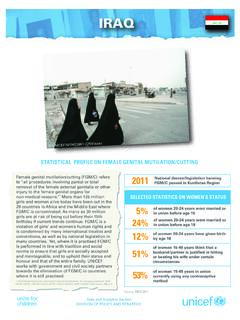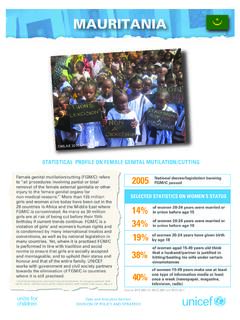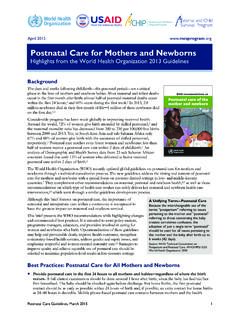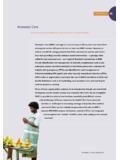Transcription of Maternal and Newborn Health Disparities Uganda
1 UgandaMaternal and Newborn Health Disparities UNICEF/UNI87744/Noorani2 UgandaKey FactsMaternal and Newborn Health Disparities in UgandaUganda reference tableDemographic indicatorsTotal population (thousands)1201539,032 Total live births (thousands)120151,665 Total Fertility Rate (number of children per woman)120156 Adolescent birth rate (per 1,000 women 15-19)102013140 Impact indicatorsMaternal mortality ratio (per 100,000 live births)42015343 Average annual rate of MMR reduction between 1990 and 2015 (%)520153 Lifetime risk of Maternal death: 1 in x4201547 Stillbirth rate (per 1,000 total births)6201521 Preterm birth rate (per 100 live births)7201014 Under-five mortality rate (per 1,000 live births)3201555 Under-five deaths that are Newborn (%)3201535 Neonatal mortality rate (per 1,000 live births)3201519 Neonatal deaths (thousands)3201530 Service DeliveryAvailability of EmONC Services (% of minimum acceptable level)8200334 Physician density (per 1,000 population)920050.
2 1 Nurse and midwife density (per 1,000 population) 3 UgandaMaternal and Newborn Health DisparitiesIn 2015, approximately 1,700,000 babies were born in Uganda , or around 4,600 every Among young women (aged 20-24), 33 percent gave birth by age 81 babies will die each day before reaching their first month3; 96 stillbirths occur every Neonatal mortality rate: Uganda s neonatal mortality rate (NMR)^ is 19 deaths per 1,000 live in rural areas is 30 deaths per 1,000 live births and 31 deaths per 1,000 live births in urban among the poorest households is 26 neonatal deaths per 1,000 live births, compared to 34 deaths per 1,000 live births among the richest mortality rat es, by background characteristics, 2011 Number of neonatal deaths(per 1,000 live births) ,205101520253035404550 Mother sEducationMother sAgeHouseholdWealthResidenceRuralPoorest No educationHighereducation Richest30 Urban3134432636 Aged20 29 Aged< 202732<20years>20yearsThe NMR for younger mothers (43 per 1,000 live births) is times higher than for mothers aged 20-29 (27 per 1,000 live births).
3 2 Neonatal mortality rat e for newborns with mothers: as likely to die during the first month of life compared to those born to mothers with no :1 Newborns with bettereducated mothers are1 in3young women (aged 20-24) have given birth by age UgandaCoverage care for mothersCoverage care for newbornsOtherDemand for family planning satisfied by modern methods (%)Antenatal care coverage at least 4 times (%)aSkilled attendant at birth (%)Institutional delivery (%)Delivered by caesarean section (%) postnatal care of mothers within 2 days (%) postnatal care of newborns within 2 days (%) Newborn weighed at birth (%)Early initiation of breast-feeding (%)Exclusive breast-feeding (<6 months) (%)BCG vaccine for Newborn (%)DPT 1 vaccination received (%)**Tetanus protection for newborns (%)Birth registration (%)Births by age 18 (%) a,#Residence Urban57.
4 Ratio (urban to rural) ratio (urban to rural)Household Wealth 247. 8 PoorestHousehold wealth ratio (richest to poorest) . wealth ratio (richest to poorest)Mother s ageLess than than 20 Mother s age20-3447. s education No 6 . 3 . educationMother s educationPrimary37. 3 . 3 . s education ratio (highest to lowest)2 .. s education ratio (highest to lowest) Disparities in key Maternal and Newborn Health interventions, Uganda , 20112 HIV/AIDS, disease, , NCDs, < , , 1%Acuterespiratoryinfections, asphyxiaand birth ,5% Causes of Neonatal Mortality, 2015In Uganda , the main causes of neonatal deaths in 2015 were birth asphyxia ( percent), prematurity ( percent) and sepsis ( percent).11 Uganda 544% of mothers in the poorest households have a skilled attendant at birth compared PoorestRichest.
5 88% of mothers in the ric hest care for mothersCoverage care for newbornsOtherDemand for family planning satisfied by modern methods (%)Antenatal care coverage at least 4 times (%)aSkilled attendant at birth (%)Institutional delivery (%)Delivered by caesarean section (%) postnatal care of mothers within 2 days (%) postnatal care of newborns within 2 days (%) Newborn weighed at birth (%)Early initiation of breast-feeding (%)Exclusive breast-feeding (<6 months) (%)BCG vaccine for Newborn (%)DPT 1 vaccination received (%)**Tetanus protection for newborns (%)Birth registration (%)Births by age 18 (%) a,#Residence Urban57. ratio (urban to rural) ratio (urban to rural)Household Wealth 247. 8 PoorestHousehold wealth ratio (richest to poorest).
6 Wealth ratio (richest to poorest)Mother s ageLess than than 20 Mother s age20-3447. s education No 6 . 3 . educationMother s educationPrimary37. 3 . 3 . s education ratio (highest to lowest)2 .. s education ratio (highest to lowest) Maternal and Newborn Health coverage indicators By residence:2 In rural areas, 46 percent of women made at least 4 antenatal care (ANC) visits compared to 57 percent in urban areas. Coverage of skilled attendance at birth is 53 percent in rural areas, compared to 89 percent in urban areas. 9 percent of newborns in rural areas receive postnatal care (PNC) within 2 days after birth, compared to 21 percent in urban household wealth:2 Only 44 percent of mothers in the poorest households had a skilled attendant at birth, compared to 88 percent of mothers in the richest households.
7 20 percent of newborns in the richest households receive PNC within 2 days after birth, compared to 11 percent among the poorest households. 80 of newborns among the richest households are weighed at birth, compared to 40 percent of newborns in the poorest for tables: 0-24 % 25-49 % 50-74 % 75 -100% Data not available6 UgandaCoverage care for mothersCoverage care for newbornsOtherDemand for family planning satisfied by modern methods (%)Antenatal care coverage at least 4 times (%)Skilled attendant at birth (%)Institutional delivery (%)Delivered by caesarean section (%) postnatal care of mothers within 2 days (%) postnatal care of newborns within 2 days (%) Newborn weighed at birth (%)Early initiation of breast-feeding (%)Exclusive breast-feeding (<6 months) (%)BCG vaccine for Newborn (%)DPT 1 vaccination received (%)**Tetanus protection for newborns (%)Birth registration (%)Births by age 18 (%)#National 3.
8 4 . 4 . 3 . 4 . 8 .. HighlandsRegional performanceHighestvalueCentralCentralCen tralCentralCentralCentralCentralWesternE asternNorthernNorthernCentralHighestvalu eRegional 3 .1 Ratio (highest to lowest) (highest to lowest)Skilled attendant at birthPostnatal care of ne wborns within 2 daysEarly initiation of breastfeedingPercent2 WesternEasternNorthernCentral01020304050 6070809010058524156495850725121314 Selected Maternal and Newborn Health indicators, by region, 2011By mother s age:2 Mothers aged 20-34 and younger mothers (aged less than 20) have similar levels of skilled attendance at birth (57 percent and 67 percent, respectively). Their newborns receive low levels of postnatal care : 11 percent and 11 percent, respectively. 58 percent of newborns born to younger mothers (aged less than 20) were weighed at birth , compared to 50 percent of newborns born to mothers aged in key Maternal and Newborn Health interventions, Uganda , 20112 Uganda 7 Coverage care for mothersCoverage care for newbornsOtherDemand for family planning satisfied by modern methods (%)Antenatal care coverage at least 4 times (%)Skilled attendant at birth (%)Institutional delivery (%)Delivered by caesarean section (%) postnatal care of mothers within 2 days (%) postnatal care of newborns within 2 days (%) Newborn weighed at birth (%)Early initiation of breast-feeding (%)Exclusive breast-feeding (<6 months) (%)BCG vaccine for Newborn (%)DPT 1 vaccination received (%)
9 **Tetanus protection for newborns (%)Birth registration (%)Births by age 18 (%)#National 3 . 4 . 4 . 3 . 4 . 8 .. HighlandsRegional performanceHighestvalueCentralCentralCen tralCentralCentralCentralCentralWesternE asternNorthernNorthernCentralHighestvalu eRegional 3 .1 Ratio (highest to lowest) (highest to lowest)By mother s education:2 Only 38 percent of mothers with no education had a skilled attendant at birth, compared to 55 percent with primary education and 93 percent for mothers with higher education. 8 percent of newborns are checked within two days after birth if their mothers have no education, compared to 9 percent of mothers with a primary education and 23 percent of mothers who received higher education. 89 percent of newborns born to mothers with higher education were weighed at birth, compared to 29 percent of newborns born to mothers with no geographic region:2 The region with the highest coverage of skilled birth attendance is Central with 72 percent; the lowest coverage is Western with 49 percent a difference of times.
10 Central has the highest coverage of PNC for newborns (within 2 days after birth) with 14 percent while Western has the lowest coverage at 5 percent a difference of times. 62 percent of newborns were weighed at birth in Central region, compared to the lowest coverage of 41 percent in Western better educated the mother is, the more likely she will receive critical mater nal Health services38%55%93%Pr imaryNoneHigherPercentage of women having a skilled birth attendant relative to their education levelKey for tables: 0-24 % 25-49 % 50-74 % 75 -100% Data not available8 UgandaSources:1 United Nations, Department of Economic and Social Affairs, Population Division (2015). World Population Prospects: The 2015 Uganda Demographic and Health Survey 2011 via the DHS Program STAT compiler.
